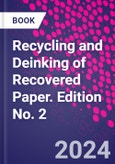Recycling and Deinking of Recovered Paper, Second Edition covers recent advances in recycling technologies. This second edition examines this new process, which is more eco-friendly than the virgin-papermaking process, and which uses less energy and natural resources, produces less solid waste and fewer atmospheric emissions, and helps to preserve natural resources and landfill space. In addition, the most recent information about the recycling of fibers into various grades of paper and board, the control of stickies, and the effects of recycled fiber on paper machines are also covered.
Recycling technologies have been improved in recent years due to advances in pulping, flotation deinking, and cleaning/screening, resulting in the quality of paper made from secondary fibers remarkably approaching that of virgin paper.
Please Note: This is an On Demand product, delivery may take up to 11 working days after payment has been received.
Table of Contents
1. Introduction
2. Legislation for use of recycled paper
3. Collection systems and sorting
4. Process steps in recycled fibre processing
5. System and process design for different paper and board grades
6. Effects of recycling on pulp quality
7. Chemicals used in deinking systems and their function
8. Enzymatic deinking
9. Bleaching of deinked pulp
10. Refining of recycled fibres
11. Improvement of drainability of recycled fibers
12. Effects of recycled fibre on paper machines
13. Control of stickies
14. Water Reuse, Wastewater Treatment and Closed-Cycle Operation
15. Case studies on Paper recycling
16. Environmental aspects
17. End use of Recovered Paper other than Papermaking
18. Future of deinking








